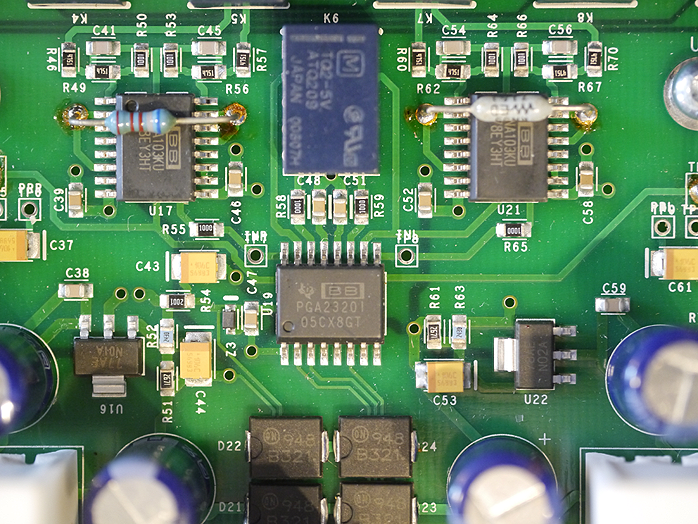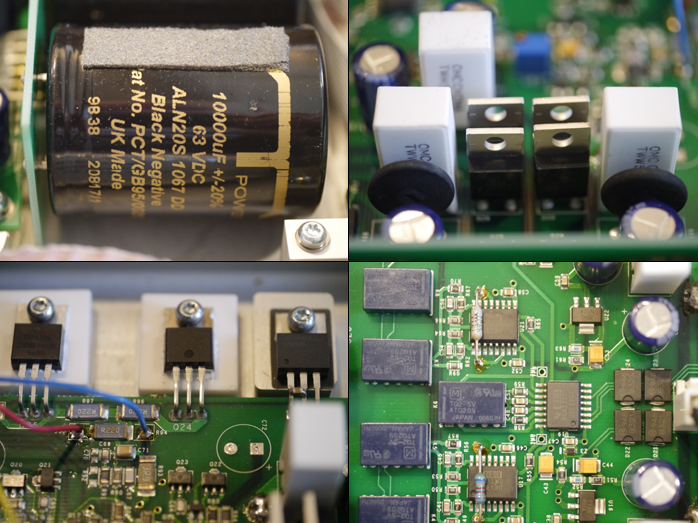This review page is supported in part by the sponsors whose ad banners are displayed below |
 |
 |
In its AC filter section the C50 sports the same very small Mexican CCI 1012 filter coil as the MC. There are four burly 10.000μf/63VDC four-pole low-induction T-Net capacitors, more Burr Brown INA series op amps, more Adum 1401 galvanic isolator chips, the same Burr Brown volume IC...
|

|
... nine Panasonic ATQ209 signal relays, 11 voltage regulators, two bias trim pots and two International Rectifier power Mosfets per side for what some would call a single-ended i.e. non-paralleled push/pull output stage.
|
 |
These output devices plus three of the voltage regulators mount to special spacers to decouple magnetically from the machined aluminum shell which doesn't sport the same sub divisions as the MC.
|
|
|
Here are two Burr-Brown opamps and the volume IC.
|
 |
|
| To learn what type of overall circuit architectures these various bits combine into requires brief history. The C50 is a joint venture between MIT alumnus Jeff Kalt and Denis Morecroft of British firm DNM Audio. DNM's motto is 'radically different thinking in high fidelity'. These men were introduced by René Reuter who leads the Swiss/German import house Reson which both of their companies share. DNM is famous for their pioneering work in plexiglas enclosures, three-dimensional circuit boards, cable-embedded compensation filters and T-network capacitors of which the C50 has four. Their PA3Δ amplifier platform embodies all their advanced research. For the C50 Jeff contracted with Denis for circuit tuning and slightly scaled-up power over his own machines. The circuit starts with an op-amp gain stage followed by the PGA-2320 volume control and bipolar drivers. This
terminates in a class A/B complementary output stage. |
|
|
Its Mosfets are decoupled with 5mm aluminium oxide spacers of good thermal conductivity without being magnetic to avoid eddy current interaction with Resolution's metal chassis. The power supply incorporates unique DC regulation, its small toroid is dedicated to all processing functions, the display and standby. Much time was spent perfecting the sonic performance also for the low playback levels which many users actually listen to most of the time. The circuit tuning exploits Denis' well-established approach to eliminating ultrasonic micro oscillations and intermodulation distortion that's usually caused by feedback errors.
|
|
|
|
 |
The Music Center's pater familias was the Resolution Audio CD-50 player with analog-domain variable outputs which enjoyed something of a cult following and formed the basis for the first BAT player. Its CD-55 successor was eventually discontinued when the drive mechanism became unavailable. Then two years of R&D passed before the two-box Opus 21 with CD/ROM drive replaced it, introduced a new half-width aesthetic and spawned the matching 35wpc Lily integrated which already was based on a DNM platform. Today's Cantata components thus continue where the Opus 21 kit left off. The MC completely floats its DAC via magnetic isolation from its Sony transport, display, USB/computer connection and all other digital sources. The optional Pont Neuf is an Ethernet/USB bridge powered by the computer's USB port. It connects directly to a home network for a wired connection up to 30 meters (or converts to wireless). The Pont Neuf is limited to 96kHz but extends USB's 5-meter cable limit by a factor of six. |
|
Designer Jeff Kalt adds: "Denis likes to keep things simple but optimizes them in some rather unusual creative ways. For example he puts a lot of attention on minimizing eddy currents (his acrylic chassis itself is designed with that in mind). We take inspiration from this and adapt it to our requirements with those white aluminum oxide blocks. The physical separation from the chassis dramatically reduces eddy currents for best sonic results. We feel that by far the biggest eddy current effect is where the most current flows - at the output of the amplifier. Denis also has a different approach to feedback. Global feedback has rightfully earned a bad reputation since it's usually applied to improve measured performance but unwittingly at the expense of sonic quality. Years ago Denis undertook a study of amplifier feedback design to discover certain key principles largely ignored by audio designers. These principles are founded in conventional control theory. Because they are applied in the ultrasonic frequency ranges however, they don't affect conventional audio amplifier measurements. Yet they are clearly audible! In fact the final tuning of the amplifier is done by ear whilst making slight changes in the 100kHz to 1MHz range.
"The
T-network capacitors in the power supply are custom-designed by Denis who found a manufacturer willing to make them to his specs. These caps use separate input and output terminals which turns the internal parasitic inductance from liability to benefit. The circuit is just a two gain-stage amplifier. The front end is a discrete bipolar circuit and the output stage uses a single pair of FETs per channel. This circuit was originally a 30wpc design but with the significant cooling of our milled aluminum chassis we were able to increase bias current to the output devices, double power supply energy storage and get a really great-sounding 50 watts. The Music Center inherits many of the design elements we learnt from this collaboration. On the digital side we shun asynchronous sample rate converters but insist on asynchronous USB. Our digital filters are purely synchronous using our proprietary DSP code at 16x when the input is 44.1 or 48kHz.
|
 |
"The Cantata uses the same ultra-low jitter master clock located in close proximity to the DACs regardless of whether the audio source is USB, Ethernet or the internal drive. On the Burr Brown 1704 multibit R-2R ladders we have yet to find a delta-sigma DAC that sounds better. These DACs have current outputs so we use passive I/V conversion together with a passive anti-imaging filter. Gain is applied using an instrumentation amplifier. The combination of digital oversampling, passive I/V and passive anti-imaging filter results in a very well-behaved signal (low noise and free of high-frequency artifacts) before any active circuitry is encountered. One of our main objections to delta-sigma designs is the amount of very high-frequency energy they inject into active circuits which inevitably results in all sorts of distortions.
Maybe the place to close is to indicate what we were trying to achieve with the Cantata products and hopefully have. We wanted to create a distinctive yet highly functional chassis. That careful collaboration with the Neal Feay company resulted in something pretty much everybody seems to appreciate. Certainly a pretty box wasn't all we wanted though. The products had to have performance we were very proud of. It needed to engage and hold the listener. It needed to be not just a product but a platform that could evolve as technology changes and we find ways to improve features, flexibility or sonic performance. In short, it needed to provide genuine value."
At Munich HighEnd 2013 Resolution's setup was an open corner on the open floor, Gallo Strada 2 speakers on the floor firing up. Minimalist to the bone and just as unobtrusive, this presentation drove home the company's strong focus on marrying real-world relevant performance with life-style sensibilities. My intro called it smart. Whilst this gear enjoyed plenty of coverage when first introduced—the looks remain a head turner to this day—the modest-powered integrated C50 got rather less attention than its flashier spec'd Music Center sibling.
|
 |
My review thus focuses on the amp, then explores the US duo's system performance to the equivalent Revo DS-1 & IPA-140 combo from Italian firm Norma which in Europe sells for €8.740 to Resolution's $10.895 in the US. Both sources combine disc drives with comprehensive DAC access, both amps integrate preamp stages with remote control. They aim at the same audience. But would sonics and particular featurization diverge enough to make each firm's ideal buyer rather more specific than just shopping the same price range?
|
 |
  |
 |